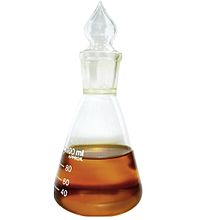
Biocrude production from orange (Citrus reticulata) peel by hydrothermal liquefaction and process optimization
Sign Up to like & getrecommendations! Published in 2021 at "Biomass Conversion and Biorefinery"
DOI: 10.1007/s13399-021-01383-3
Abstract: Hydrothermal liquefaction is a promising anaerobic thermochemical process for the conversion of wet biomass into an energy dense biocrude. In this study, the suitability of orange peel for biocrude production was investigated. The study was… read more here.
Keywords: peel; process; biocrude production; hydrothermal liquefaction ... See more keywords

Effect of temperature, water loading, and Ru/C catalyst on water-insoluble and water-soluble biocrude fractions from hydrothermal liquefaction of algae.
Sign Up to like & getrecommendations! Published in 2017 at "Bioresource technology"
DOI: 10.1016/j.biortech.2017.04.127
Abstract: Hydrothermal liquefaction (HTL) converts algal biomass into a crude bio-oil (biocrude) and aqueous-phase products. The effect of temperature, water loading, and added H2 and/or Ru/C catalyst on the properties of the biocrude that spontaneously separates… read more here.
Keywords: temperature; water; water soluble; water insoluble ... See more keywords

Aqueous phase reforming of biocrude derived from lignocellulose hydrothermal liquefaction: Conditions optimization and mechanism study
Sign Up to like & getrecommendations! Published in 2021 at "Renewable Energy"
DOI: 10.1016/j.renene.2021.04.127
Abstract: Abstract Hydrothermal liquefaction (HTL) of biomass into biocrude is attractive but the biocrude themselves are poor fuels, which need to be upgraded for further utilization. Compared with the traditional catalytic upgradation process, a non-catalytic method… read more here.
Keywords: htl; study; aqueous phase; hydrothermal liquefaction ... See more keywords

A review of fractional distillation to improve hydrothermal liquefaction biocrude characteristics; future outlook and prospects
Sign Up to like & getrecommendations! Published in 2019 at "Renewable and Sustainable Energy Reviews"
DOI: 10.1016/j.rser.2019.109355
Abstract: Hydrothermal liquefaction (HTL) is an efficient thermochemical method for biomass conversion into biocrude which could be operated with a wide range of feedstock resources. However, HTL biocrude characteristics including viscosity, density, heating value, composition and… read more here.
Keywords: biocrude characteristics; fractional distillation; hydrothermal liquefaction; distillation ... See more keywords

Use of Kappaphycus alvarezii Biomass for the Production of Carbohydrate Isopropylidene-Ketal-Based Biocrude
Sign Up to like & getrecommendations! Published in 2017 at "Energy & Fuels"
DOI: 10.1021/acs.energyfuels.7b00765
Abstract: The production of bio-hydrocarbons is a challenging task, which stimulated research and the development of different approaches to introduce biomass into the standard refinery. However, they present drawbacks that demonstrate the need for continuous research.… read more here.
Keywords: production; kappaphycus alvarezii; biomass; carbohydrate ... See more keywords

Ecological Stoichiometry Meets Ecological Engineering: Using Polycultures to Enhance the Multifunctionality of Algal Biocrude Systems.
Sign Up to like & getrecommendations! Published in 2017 at "Environmental science & technology"
DOI: 10.1021/acs.est.7b02137
Abstract: For algal biofuels to be economically sustainable and avoid exacerbating nutrient pollution, algal cultivation and processing must maximize rates of biofuel production while simultaneously minimizing the consumption of nitrogen (N) and phosphorus (P) fertilizers. We… read more here.
Keywords: efficiency biocrude; biocrude production; production; ecological stoichiometry ... See more keywords

Upgrading Algae Biocrude for a Low-Nitrogen-Containing Biofuel: Compositions, Intermediates, and Reaction Routes
Sign Up to like & getrecommendations! Published in 2017 at "Industrial & Engineering Chemistry Research"
DOI: 10.1021/acs.iecr.7b01405
Abstract: The upgrading of algae biocrude (obtained by hydrothermal liquefaction) was studied under mild conditions. Here we adopted a guard catalyst to protect the core catalyst and obtained algae biofuel with low heteroatom content at 350… read more here.
Keywords: algae biocrude; biofuel; biocrude low; upgrading algae ... See more keywords

A Comprehensive Hydrothermal Co-Liquefaction of Diverse Biowastes for Energy-Dense Biocrude Production: Synergistic and Antagonistic Effects
Sign Up to like & getrecommendations! Published in 2022 at "International Journal of Environmental Research and Public Health"
DOI: 10.3390/ijerph191710499
Abstract: Hydrothermal co-liquefaction (co-HTL) is a promising technology to valorize binary or even ternary biowastes into bioenergy. However, the complex biochemical compositions and unclear synergistic effect prevent the development of this technology. Thus, this study explored… read more here.
Keywords: antagonistic effects; biocrude; energy; synergistic antagonistic ... See more keywords

Hydrothermal Liquefaction of Pinewood Sawdust: Influence of Reaction Atmosphere
Sign Up to like & getrecommendations! Published in 2023 at "Sustainability"
DOI: 10.3390/su15086698
Abstract: Hydrothermal liquefaction (HTL) is a thermochemical process for production of biocrude oils, commonly from wet biomass under inert atmosphere (N2). Influence of reaction atmosphere on HTL of pinewood sawdust was investigated in this work, at… read more here.
Keywords: biocrude; oil; reaction atmosphere; hydrothermal liquefaction ... See more keywords